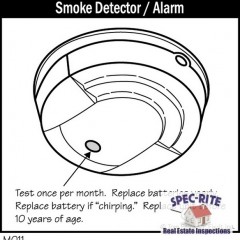Smoke Detector Requirements in California
 One of the frequent items I get calls about from lenders, real estate agents, appraisers, home buyers and sellers is “Why do I have to install smoke detectors, my home didn’t require them when it was built. And in response, that’s probably true… unless it’s a relatively new home, say in last 20 years, smoke detectors weren’t required in all the places they are now. Why? I’ll try to explain, I’ll even have a download .pdf for you to keep, if you’d like for Smoke Detectors and Carbon Monoxide Information!!
One of the frequent items I get calls about from lenders, real estate agents, appraisers, home buyers and sellers is “Why do I have to install smoke detectors, my home didn’t require them when it was built. And in response, that’s probably true… unless it’s a relatively new home, say in last 20 years, smoke detectors weren’t required in all the places they are now. Why? I’ll try to explain, I’ll even have a download .pdf for you to keep, if you’d like for Smoke Detectors and Carbon Monoxide Information!!
Why is this NOW a requirement?
For Safety and to save lives is the simple answer. Also, the building code has been written and expounded upon many times over in an effort, to ensure these devices are installed in all sleeping areas as well as adjoining areas/hallways. Plainly spoken, the state and local municipalities have made efforts to ensure that homes that didn’t originally have smoke detectors, end up with them in all currently required installation locations. It would be difficult to make a case for most any home/dwelling to not have a smoke detector, and now a Carbon Monoxide detector.
Fine, that’s what YOU say – I want the facts!!
Well, here’s a couple of snippets of requirements… there’s probably a bunch more to be found for each city/municipality that may even be stricter than what I’m writing.
- Taken from CA Health and Safety Code 13113.8a) On and after January 1, 1986, every single-family dwelling and factory-built housing, as defined in Section 19971, which is sold shall have an operable smoke detector.From California Building Code R314.3 Location. Smoke alarms shall be installed in the following locations:
1. In each sleeping room.
2. Outside each separate sleeping area in the immediate vicinity of the bedrooms.
3. On each additional story of the dwelling, including basements and habitable attics but not including crawl spaces and uninhabitable attics. In dwellings or dwelling units with split levels and without an intervening door between the adjacent levels, a smoke alarm installed on the upper level shall suffice for the adjacent lower level provided that the lower level is less than one full story below the upper level.When more than one smoke alarm is required to be installed within an individual dwelling unit the alarm devices shall be interconnected in such a manner that the actuation of one alarm will activate all of the alarms in the individual unit. There are exceptions in most communities if inter-connecting the devices would result in damage to property, unless construction is taking place.Click on this link to Download the Smoke Detector and Carbon Monoxide Detector RequirementsI’ve put together, save it for your files!

Sorry, comments are closed for this post.